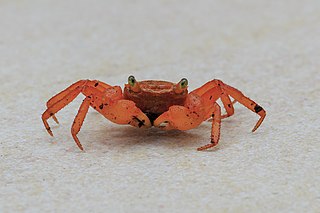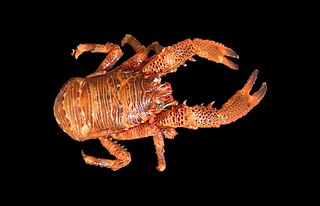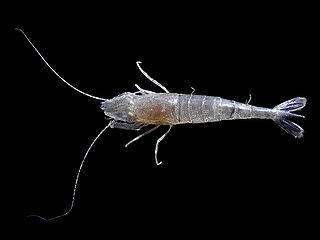
In Greek mythology, Amymone was a daughter of Danaus, king of Libya and Europe, a queen. As the "blameless" Danaid, her name identifies her as, perhaps, identical to Hypermnestra, also the one Danaid who did not assassinate her Egyptian husband on their wedding night, as her 49 sisters did. The author of the Bibliotheca, in his list of names for the Danaids, does mention both Hypermnestra and Amymone, however.
Johannes Govertus de Man, was a Dutch biologist. He was assistant curator at the Rijksmuseum van Natuurlijke Historie in Leiden, where he specialised in free-living nematodes and decapod crustaceans, although he also wrote papers on flatworms, sipunculids and, in his dissertation only, vertebrates. His change away from vertebrates disappointed the director of the museum, and de Man left his job there after eleven years. For the rest of his life, de Man worked at his parents' house in Middelburg and later at a house near the shore at Yerseke in the Oosterschelde estuary, relying on his family's private income.

Automate is a genus of pistol shrimp of the family Alpheidae, containing the following species:
Nicochares was an Athenian poet of the Old Comedy, son of the comic playwright Philonides and contemporary with Aristophanes. The titles of Nicochares' plays, as enumerated by Suidas, are, Αμυμώνη (Amymone), Πέλοψ (Pelops), Γαλάτεια (Galatea), Ηρακλής Γάμων, Ηρακλής Χορηγός, Κρήτες (Cretans), Λάκωνες, Λημνίαι, Κένταυροι (Centaurs), and Χειρογάστορες. Augustus Meineke suggested that the Amymone and Pelops may have been alternative names for the same work, as the Suda lists the two works together when all of the others are in alphabetical order, and a fragment of Amymone quoted by Athenaeus mentions Oenomaus, the father-in-law of Pelops.

Palaemonidae is a family of shrimp in the order Decapoda. Many species are carnivores that eat small invertebrates, and can be found in any aquatic habitat except the deep sea. One significant genus is Macrobrachium, which contains commercially fished species. Others inhabit coral reefs, where they associate with certain invertebrates, such as sponges, cnidarians, mollusks, and echinoderms, as cleaner shrimps, parasites, or commensals. They generally feed on detritus, though some are carnivores and hunt tiny animals.

Palaemon is a genus of caridean shrimp of the family Palaemonidae. The conventional circumscription of the genus Palaemon is probably paraphyletic. Molecular data suggest that Palaemonetes, as well as the genera Exopalaemon and Couteriella, are nested within Palaemon. Phylogenetic affinities in these groups correspond better with geographical origin than conventional genus assignments.

Geosesarma is genus of small freshwater or terrestrial crabs, typically less than 10 mm (0.4 in) across the carapace. They live and reproduce on land with the larval stages inside the egg. They are found from India, through Southeast Asia, to the Solomon Islands and Hawaii.

Galathea is one of the largest genera of squat lobsters, containing 70 currently recognised species. Most species of Galathea live in shallow waters.

Macrobrachium is a genus of freshwater prawns or shrimps characterised by the extreme enlargement of the second pair of pereiopods, at least in the male.
Cuapetes agag is a species of shrimp found in New Caledonia, Melanesia, Queensland, and the Red Sea. It was first named by Kemp in 1922.
Cuapetes andamanensis is a species of shrimp found in the Pacific and Indian Oceans. It was first named by Kemp in 1922.

Hippa is a genus of decapod crustaceans in the family Hippidae, containing the following species:

Crangon is a genus of shrimp.

Cuapetes is a genus of shrimp in the family Palaemonidae, comprising the following species:
Cuapetes elegans is a shrimp species in the genus Cuapetes.

Mestra is a genus of nymphalid butterfly. It contains the single species Mestra dorcas, the Jamaican mestra, which is found from southern North America to South America and possibly Mestra cana, the St Lucia mestra, found in the Lesser Antilles.

Pseudochazara mamurra, the buff Asian grayling, is a species of butterfly in the family Nymphalidae. It is confined to Albania, Greece, and Turkey. The habitat consists of slopes in steep river valleys.
Cuapetes lacertae, previously known as Periclimenes lacertae, is a species of shrimp belonging to the family Palaemonidae. Its name is due to the fact the first specimen was collected from Lizard Island: lacerta being Latin for "lizard".
Penestomus is a genus of African araneomorph spiders in the family Penestomidae, and was first described by Eugène Louis Simon in 1902. The genus was formerly included in the family Eresidae, but was elevated to its own family in 2010. It is now considered closer to Zodariidae.











